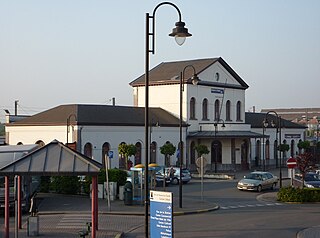Related Research Articles

Braine-le-Comte is a city and municipality of Wallonia located in the province of Hainaut, Belgium.

The Brass Era is an American term for the early period of automotive manufacturing, named for the prominent brass fittings used during this time for such features as lights and radiators. It is generally considered to encompass 1896 through 1915, a time when cars were often referred to as horseless carriages.
The Alesbury was an Irish automobile. It was powered by an 8/10 hp Stevens-Duryea engine and had solid tires. The car was exhibited in Dublin in 1907, and manufacture lasted from then until 1908.
The Allen was a short-lived American automobile manufactured in Philadelphia, Pennsylvania, from 1913 to 1914.

The Argo was a short-lived American automobile manufactured by the Argo Motor Co in Jackson, Michigan, between 1914 and 1918. Previously, the factory had been used by the Standard Electric Car Co to build an electric car.

L'Aster, Aster, Ateliers de Construction Mecanique l'Aster, was a French manufacturer of automobiles and the leading supplier of engines to other manufacturers from the late 1890s until circa 1910/12. Although primarily known as an engine mass manufacturer the company also produced chassis for coach-works and a complete range of components.

Royale Union Tubize-Braine, also known as Tubize-Braine or RUTB, is a Belgian football club based in the cities of Tubize and Braine-le-Comte.

Brussels-South railway station is a major railway station in Brussels, Belgium. Geographically, it is located in Saint-Gilles/Sint-Gillis on the border with the adjacent municipality of Anderlecht and just south of the City of Brussels.

The Otomo was a Japanese automobile built by Mr. Hayataya Toyokawa from 1924 to 1927 at the Hakuyosha Ironworks in Tokyo. It was meant to build upon his experimental Ales cars of 1921. Otomo offered an air-cooled 944 cc four-cylinder light car, available as two- or four-seat tourer or saloon (sedan), or as a van. This was joined in 1926 by a water-cooled 24 hp model. During this time, Otomo was one of only two Japanese automakers, joined by the Japanese established Gorham Automobile Company, financed by American aircraft engineer William R. Gorham. The remnants of the Gorham Automobile Company became the Nissan Motor Company Ltd. The car found it difficult to compete with Ford Model T's being manufactured at Yokohama, and Chevrolet Capitols being built at Osaka, and the company was integrated with other smaller Japanese automobile manufacturers. The 1923 Great Kantō earthquake also disrupted the local economy, with manufacturing resources greatly affecting business operations.
The Flaid was a Belgian automobile manufactured from 1920 until 1921 in Liège. A 10/12 hp light car with 1095 cc four-cylinder engine, it was designed for export to Britain. A stand was booked at the 1920 British Motor Show but the car never appeared.
The Societé Générale des Voitures Automobiles Otto of Paris manufactured the Otto car from 1900 to 1914, and the F.L. from 1909 to 1914.

The Arrondissement of Soignies is one of the seven administrative arrondissements in the Walloon province of Hainaut, Belgium.
The Benham was an American automobile manufactured in Detroit, Michigan, by the Benham Manufacturing Company from 1914 to 1917. Approximately 60 units were produced. Benham Manufacturing was the successor to the S&M. The Benham had a Continental engine.
The Fischer was an American brass era automobile manufactured in Detroit, Michigan by the G.J. Fischer Company in 1914. It was a light car, built as a two- or four-seater model, including a sedan. It had a Perkins four-cylinder water-cooled 1.2L engine. It had a selective transmission and shaft drive. The two-seater cost $525, and the sedan cost $845.
The Flyer was an American brass era automobile manufactured in Mt. Clemens, Michigan by the Flyer Motor Car Company from 1913 to 1914. The Flyer had a monobloc four-cylinder water-cooled engine with selective transmission.

The Aero Minor is a Czechoslovakia automobile that was manufactured by Aero from 1946 until 1952. It was designed by Jawa Motors engineers on their previous Jawa Minor design; they worked on it secretly during the German occupation of Czechoslovakia. It had a two-cylinder, two-stroke engine with 615cc displacement and front wheel drive. The car reached speeds of up to 90 km/h. The engine produced 20 hp and it had a fuel consumption of 8 L/100 km. It carried saloon and station wagon bodies.

Founded in Kansas City, Missouri in 1908, the American Automobile Manufacturing Company acquired the Jonz Automobile Company of Beatrice, Nebraska in 1910 with a planned initial capitalization of $1,000,000. In early news releases, the company claimed "$100,000 of the stock has been subscribed for by Chicago and Kansas City men". Initial plans called for the establishment of factories in Kansas City and Louisville, Kentucky.
Edward Butler (1862–1940) was an English inventor who produced an early three-wheeled petrol automobile called the Butler Petrol Cycle, which is accepted by many as the first British car.

Braine-le-Comte railway station is a railway station in Braine-le-Comte, Hainaut, Belgium. The station opened on 31 October 1841 and is located on railway lines 96, 117 and 123. The train services are operated by the National Railway Company of Belgium (SNCB/NMBS).

Lafitte was a French automobile manufactured in Paris from 1923–1928. The 'SA de Construction de Voiturettes Th. Lafitte', owned by Theodore Laffitte, manufactured a light cyclecar which was renowned for its innovative engineering. It incorporated a three-cylinder radial engine mounted in a hinged cage, which was tilted by the driver to engage and vary the ratio of the friction drive to the rear wheels. Uniquely, the 'variable ratio' friction drive consisted of a convex steel flywheel and a concave 'clutch plate' that was faced by wound strips of paper or sometimes leather.
References
- Georgano, G.N., "Alatac", in G.N. Georgano, ed., The Complete Encyclopedia of Motorcars 1885-1968 (New York: E.P. Dutton and Co., 1974), pp.31.